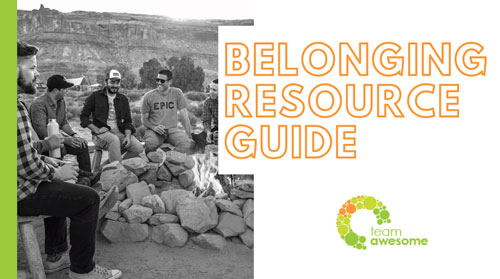The somewhat-kitschy phrase of being your “whole self” has been around the block. But when it comes to the workplace, we are scared of the consequences of employees bringing their whole selves to work. For decades, managers have preferred people keep their humanity to themselves in order to maintain a neat and tidy workplace without any of the messiness that life brings with it.
I believe we go to work in search of belonging. And if that is true, then our organizations have some work to do. And we all have some work to do. That means creating environments at work where we can all let our humanity show, and as individuals be willing to take tiny leaps of faith in showing more and more glimpses of our whole selves to each other. Sure, it will be a little messier. And I imagine all of us breathing a collective sigh of relief when the weight lifts off our shoulders that comes from stuffing our human selves into a bag only for our bodies to be inhabited by some skim-milk, corporate versions of ourselves from 9-5, Monday through Friday.
What does whole look like?
If we want people to feel whole that means that they can come to work, just as they are. But this isn’t happening. A study from Deloitte found that 61% of employees surveyed report they are “covering” on some personal dimension (like, appearance or affiliation). And that is just 61% that realize they are covering some aspect of themselves! I was well into my thirties before I realized which parts of myself I was covering when I walked into work. This might be the woman who doesn’t talk about her kids at the risk of being seen as uncommitted. This could be the young man who doesn’t share about his weekends because he spends them at the mosque. Whether or not the stories we tell ourselves about what is or is not safe to share are true, the uncertainty is enough to lead to covering.
Companies must examine how fully the organization encourages different styles of thinking (such as whether a person is an introvert or an extrovert) or embracing varied styles of leadership (not everyone has to be the same dominant, driving force that the CEO is).
Our organizations can assess how they truly create more flexible work environments, to allow more people that have lives outside of work to contribute more fully. We can build systems and purposeful interactions that prioritize people connecting and collaborating.
When we don’t feel whole…
There are examples everywhere of people who feel less-than-whole in the workplace. We just don’t want to acknowledge these inconvenient truths because it means the ownership is on us as leaders to create change. Here are a few examples of different peoples’ real, lived experiences at work. It makes sense (albeit disheartening) why they cover some aspect of themselves, and these important stories go beyond what I can articulate with my own experiences.
First, a woman of color wrote about the mental load she carries every day in the article titled, ”I’m Exhausted From Trying to Be the ‘Right’ Kind of Black Girl at Work”:
“I hate meaningless conversation but when I go to work, I become a master at small talk. I transform into a watered-down version of myself to ensure that I am palatable … Wear your natural curls, but not too big so you don’t bring too much attention to your fro … Don’t show any emotions, especially anger or irritation.”
— D. Shante
A working mom wrote in a viral Facebook post last year:
“Go back to work 6-8 weeks after having the baby… Keep your mind on work, and not your tiny helpless baby that is being watched and cared for by someone other than you… Also … take 2-3 pumping breaks a day at work, but don’t let it throw you off your game or let you lose your focus. Sorry, you are now out of vacation time because you used it all for time taking your kids to appointments or when your childcare is unavailable. You should go on vacations though. It’s good to relax and unwind from work. Makes you a better employee.”
— Sarah Buckley Friedberg
An introvert wrote about a lifetime of cold lunches:
“This is why we introverts bring large water bottles or coffee thermoses from home to avoid trips to the break room. When I worked in an office, I was lucky enough to have my own space with a door I could close. At my low points, I would turn off my lights, lock my door, and eat my lunch cold — no way was I going to the break room to use the microwave!”
— Ashley Burk
Do these stories sound familiar to you? Can you imagine experiences just like these in your organization, even though you may not have realized it before? (At least one of you introverts reading this has walked the long way to the bathroom to avoid people, I am sure of it.)
Steps towards feeling whole
To help people feel whole, try this.
For the organization, show with supportive actions that you welcome and honor different aspects of human lives. Don’t just say it, show it.
I worked with a company (within the last five years, mind you) who still had very detailed, conservative dress code policies that classified wardrobe choices by men versus women, made it clear that tattoos were not encouraged, and that colored hair was prohibited. No sleeveless tops, cropped pants, or open-toed shoes for women. I am dead serious, it included the word “pantyhose.” What does this tell people when they read between the lines? This translates to… “I can’t even show my tattoos, I am DEFINITELY not going to tell people I went to a Megadeath concert this weekend!” or “I don’t identify with binary gender choices, and I definitely don’t feel safe expressing myself fully if my only options are (A) wear a tie or (B) wear pantyhose.”
This is an example of a company saying they support diverse views, but showing different actions.
For yourself, start where you are. Ask yourself, what parts of you are you covering, even a little? In what ways could you show up more fully as yourself with your team? Find ways to set the example to show people it is safe to share their humanity. Leaders in particular must lead by example, through their actions, to show that it is accepted and encouraged to bring our whole selves to the table. Simply saying it and showing different action will not cut it. One of the most valuable examples one of my former bosses set was to openly talk about his two young daughters. It made navigating new parenthood in the workplace much easier and more accepted for me.
Imagine if we all were so privileged to safely bring our whole selves to work. Let me be clear, this does not welcome damaging behavior that inhibits the inclusivity of others. For example, an employee cannot come in pontificating the benefits of “conversion therapy” to the detriment of a gay employee. Bringing our whole selves does not mean we get to snuff out that of others. But we have a lot of opportunity to inch closer to an environment that it safe for interpersonal sharing and that honors our whole selves, not just the part that celebrates corporate convenience.
And it is a privilege. Plenty of people have spent every waking hour of their careers having to scan their environments for safety and belonging rather than it just happening automatically. It is a form of privilege to not have to feel like covering, or to never even have to contribute any mental load at all to seeing if you belong. It is important for those who embody these privileges to gain awareness of how others are not granted that automatically, and begin to create pockets of wholeness, safety and belonging where we are for others.
My ask of you today is to go forward and identify one way you can show up more fully to those around you. And identify one way you can encourage those around you to show up as their full messy, human selves. You showing up as yourself gives others permission to do the same, and you will begin a chain reaction of change.
About the author:
Katie Rasoul is a keynote speaker, author, coach and Chief Awesome Officer for Team Awesome, a leadership coaching and culture consulting firm. She is a TEDx speaker alumna, author of the best-selling book, Hidden Brilliance: A High-Achieving Introvert’s Guide to Self-Discovery, Leadership and Playing Big, and co-host of The Life and Leadership Podcast.
To learn more about Katie’s signature keynote talk, “Beyond Diversity & Inclusion to Belonging,” visit www.katierasoul.com.



Recent Comments